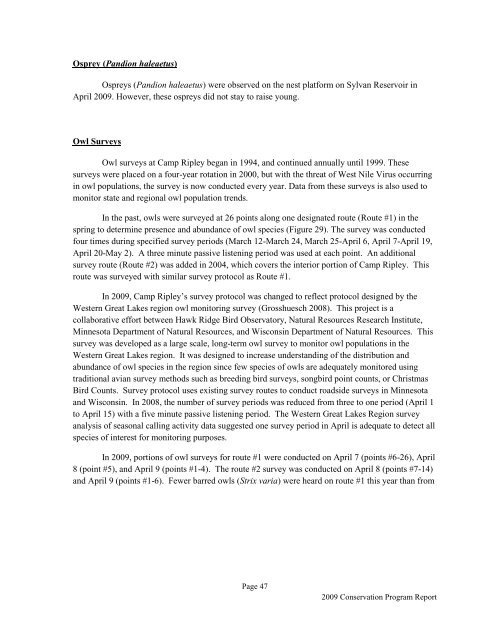camp ripley and arden hills minnesota army national guard training ...
camp ripley and arden hills minnesota army national guard training ...
camp ripley and arden hills minnesota army national guard training ...
Create successful ePaper yourself
Turn your PDF publications into a flip-book with our unique Google optimized e-Paper software.
Osprey (P<strong>and</strong>ion haleaetus)<br />
Ospreys (P<strong>and</strong>ion haleaetus) were observed on the nest platform on Sylvan Reservoir in<br />
April 2009. However, these ospreys did not stay to raise young.<br />
Owl Surveys<br />
Owl surveys at Camp Ripley began in 1994, <strong>and</strong> continued annually until 1999. These<br />
surveys were placed on a four-year rotation in 2000, but with the threat of West Nile Virus occurring<br />
in owl populations, the survey is now conducted every year. Data from these surveys is also used to<br />
monitor state <strong>and</strong> regional owl population trends.<br />
In the past, owls were surveyed at 26 points along one designated route (Route #1) in the<br />
spring to determine presence <strong>and</strong> abundance of owl species (Figure 29). The survey was conducted<br />
four times during specified survey periods (March 12-March 24, March 25-April 6, April 7-April 19,<br />
April 20-May 2). A three minute passive listening period was used at each point. An additional<br />
survey route (Route #2) was added in 2004, which covers the interior portion of Camp Ripley. This<br />
route was surveyed with similar survey protocol as Route #1.<br />
In 2009, Camp Ripley‟s survey protocol was changed to reflect protocol designed by the<br />
Western Great Lakes region owl monitoring survey (Grosshuesch 2008). This project is a<br />
collaborative effort between Hawk Ridge Bird Observatory, Natural Resources Research Institute,<br />
Minnesota Department of Natural Resources, <strong>and</strong> Wisconsin Department of Natural Resources. This<br />
survey was developed as a large scale, long-term owl survey to monitor owl populations in the<br />
Western Great Lakes region. It was designed to increase underst<strong>and</strong>ing of the distribution <strong>and</strong><br />
abundance of owl species in the region since few species of owls are adequately monitored using<br />
traditional avian survey methods such as breeding bird surveys, songbird point counts, or Christmas<br />
Bird Counts. Survey protocol uses existing survey routes to conduct roadside surveys in Minnesota<br />
<strong>and</strong> Wisconsin. In 2008, the number of survey periods was reduced from three to one period (April 1<br />
to April 15) with a five minute passive listening period. The Western Great Lakes Region survey<br />
analysis of seasonal calling activity data suggested one survey period in April is adequate to detect all<br />
species of interest for monitoring purposes.<br />
In 2009, portions of owl surveys for route #1 were conducted on April 7 (points #6-26), April<br />
8 (point #5), <strong>and</strong> April 9 (points #1-4). The route #2 survey was conducted on April 8 (points #7-14)<br />
<strong>and</strong> April 9 (points #1-6). Fewer barred owls (Strix varia) were heard on route #1 this year than from<br />
Page 47<br />
2009 Conservation Program Report
















